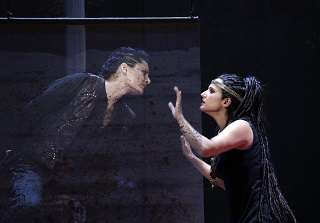|
Back
The Lure of Orientalism Pesaro
Vitrifrigo Arena
08/12/2023 - & August 15, 18, 21*, 2023
Gioachino Rossini: Aureliano in Palmira
Alexey Tartarinstev (Aureliano), Sara Blanch (Zenobia), Raffaella Lupinacci (Arsace), Marta Pluda (Publia), Sunnyboy Dladla (Oraspe), Davide Giangregorio (Licinio), Alessandro Abis (Gean Sacerdote), Elcin Adil (Un pastore)
Coro del Teatro della Fortuna, Mirca Rosciani (chorus master), Orchestra Sinfonica G. Rossini, George Petrou (conductor)
Mario Martone (stage director), Sergio Tramonti (sets), Ursula Patzak (costumes), Pasquale Mari (lighting)

R. Lupinacci, S. Blanch (© Amati Bacciardi Studio)
A dazzling vocal performance and an enchanting musical experience is the best way to describe this performance of Rossini’s Aureliano in Palmira (1813). All three lead singers were phenomenal. Spanish diva Sara Blanch is endowed with a beautiful soprano and a solid technique that enabled her to bring the Palmyran Queen Zenobia to life. Her voice may be a touch light for the imposing queen but her stage presence and acting compensated for it. Her lover, the Persian prince Arsace, sung by mezzo Raffaella Lupinacci, had the dashing physique of a young warrior that made the role scenically credible. This role was the only one Rossini wrote for a castrato, and there have been recent performances with a countertenor. However, the voices of Blanch and Lupinacci blended so well that the choice of a mezzo seems to have been a judicious one. Had Zenobia’s soprano been a bigger one, a countertenor may have been more appropriate. This opera has three thrilling duets between Zenobia and Arsace and the chemistry between Blanch and Lupinacci was felicitously magical. Their last duet, “Pur t’abbraccio una volta o mio diletto,” a summit of eroticism and tenderness, was sublime, and justly greeted with much applause from the audience.
The title role was sung by Russian tenor Alexey Tartarinstev, who’s in possession of a big yet sufficiently agile voice to portray the Roman Emperor, but whose stage presence was hampered by the libretto that made him seem less than powerful. Aureliano is drooling over Zenobia’s beauty from the moment of their first encounter. He’s hesitant to be ruthless with her or with her lover, Arsace. When he’s moved by the everlasting fidelity of the two lovers at the end of the opera, it has little dramatic effect, as he seemed to be clement all along. The fourth main character, a Roman noblewoman, Publia, is inconspicuous. As written, she’s mysteriously smitten by Arsace, who doesn’t even notice her. Mezzo Marta Pluda did her best in this lacklustre role. She only had one aria toward the end of the opera which showed her warm mezzo and dramatic potential.
Some of this opera’s music was recycled three years later into Il barbiere di Siviglia (1816), notably the overtures and the opening choral scene, which shares the melody of Il barbiere’s tenor aria “Ecco ridente.” There is even part of “Una voce poco fa” in one of the opera’s later scenes. Though written and performed when he was but twenty‑one, there is ample music of high calibre evocative of the more mature Rossini throughout the opera.
The Orchestra Sinfonica G. Rossini was well directed by early music specialist George Petrou, who allowed the music to breathe. He is also an excellent conductor of voices and pays attention to the singers’ needs.
The sets were disappointing. The Levantine setting promised some opulence, but none was on the menu. Queen Zenobia’s court was extremely modest. Panels representing tents were the extent of her abode.
Though the libretto was written by Felice Romani (1788-1865), the ingenious author of the libretti of Rossini’s Il Turco in Italia (1814), Bellini’s Norma (1831) and La sonnambula (1831), and both Donizetti’s Anna Bolena (1830) and Lucrezia Borgia (1833), it is no masterpiece. The characters, especially Aureliano, are not sufficiently developed. Moreover, the plot does not reflect historical fact. The actual Aureliano did not forgive Zenobia (or her non‑existent Persian lover). In reality, she was deprived of her throne and exiled to Rome where she was paraded in a cage to a jubilant crowd.
Although a quotation by literary critic Edward Said about this work is projected at the end of the opera, “L’Europa è forte e ben strutturata, l’Asia è lontana e sconfitta” (Europe is strong and well structured, Asia is far away and defeated), stage director Mario Martone seems to have paid little heed to Said’s critique of the opera’s blatant Orientalism (which is also the title of Dr Said’s seminal 1978 work, which established the term as a critical concept to describe the West’s contemptuous depiction of the East).
While the confused perception of history and geography in the early nineteenth century is forgivable, it is less so in the present. Romani’s libretto refers to Palmyra’s imminent fall after Aureliano crossed the Euphrates, though the city is over 200 miles from the Mesopotomian river. Aureliano evokes Arsace hiding in the Libyan desert, some 1500 miles away. Ursula Patzak’s costumes are a pastiche of the entire so‑called “Orient” stretching from Morocco to Indonesia. The women are wearing present‑day Islamic dresses with head covers, and on occasion sport colours typical of India, totally alien to the Levant.
The conservative headdress was adopted by the Arabs from the Byzantine nobility several centuries later. Moroccan‑style tea is served to Zenobia and Arsace. Palmyra’s warriors are wearing Daesh‑style black garb, confirming negative stereotypes. The costumes of third century Syrians would have been rather similar to Greek costumes of the time. However, Martone and Patzak couldn’t resist the lure of Orientalism. Nonetheless, this was a totally enjoyable performance of a rarely performed work, thanks to the brilliant singing and Rossini’s infectious melodies.
Ossama el Naggar
|